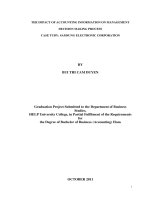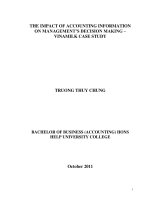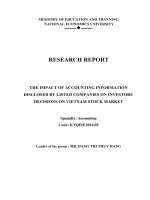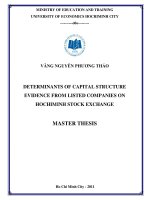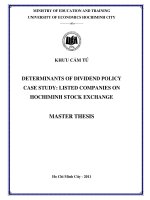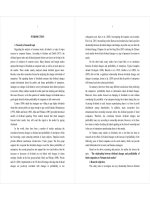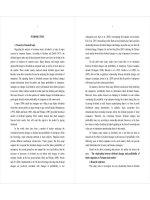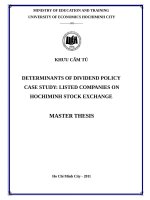THE IMPACT OF ACCOUNTING INFORMATION DISCLOSED BY LISTED COMPANIES ON INVESTORS’ DECISIONS ON VIETNAM STOCK MARKET
Bạn đang xem bản rút gọn của tài liệu. Xem và tải ngay bản đầy đủ của tài liệu tại đây (1.26 MB, 155 trang )
1
1
MINISTRY OF EDUCATION AND TRANNING
NATIONAL ECONOMICS UNIVERSITY
RESEARCH REPORT
THE IMPACT OF ACCOUNTING INFORMATION
DISCLOSED BY LISTED COMPANIES ON INVESTORS’
DECISIONS ON VIETNAM STOCK MARKET
Specialty: Accounting
Code: KTQD/E2016.02
Leader of the group : MB. DANG THI THUY HANG
2
2
Hanoi, 2016
MINISTRY OF EDUCATION AND TRANNING
NATIONAL ECONOMICS UNIVERSITY
RESEARCH REPORT
THE IMPACT OF ACCOUNTING INFORMATION
DISCLOSED BY LISTED COMPANIES ON INVESTORS’
DECISIONS ON VIETNAM STOCK MARKET
Specialty: Accounting
Code: KTQD/E2016.02
Leader of the group : MB. DANG THI THUY HANG
Members of the group: 1. PhD. TS. Pham Duc Cuong
2. PhD. Tran Thi Nam Thanh
3. MBA. Han Thi Lan Thu
4. MBA.Vu Thi Lan Huong
5. Ngo Thi Thanh Thuy
6. Nguyen Dang Kien
7. Nguyen Thi Hong Ngoc
3
3
Hanoi, 2016
4
TABLE OF CONTENT
5
TABLE OF TABLES, CHARTS
Tables:
Charts:
6
INTRODUCTION
Research Idea
Today, in order to survive and develop in the increasingly internationalized
world, listed companies must be disclosed as much information as they can to
satisfy the demands of investors. In the corporate information disclosures,
accounting information disclosures which typically are presented on the financial
statements, as a basic source of validity information to be used by different group of
users in making investing decision, including investors.
There are many studies on corporate information disclosures around the
world, even in the developed countries (US, UK, Australia, Japan, New Zealand, ...)
or in the developing countries (Iran, Jordan, Malaysia, Nigeria, Bangladesh,
Zimbabwe, Vietnam, Tunisia,...), and in the emerging economies (UAE, Greece,
China, Singapore, Hong Kong,...). Most of these researchs try to find out the impact
of factors such as firm size, structure of ownership, auditing company-big 4, etc. on
corporate disclosures (Ahmed et al. 1994, 1999; Akhtaruddin et al. 2008, 2009;
Barako et al. 2006; Buzby, 1975; Chau et al., 2001; Chen et al., 2000; Cooke, 1992;
Donnelly et al., 2008; Firth, 1979; Gerald et al., 2002; Gul et al., 2004; Haniffa et
al., 2002, Ho et al., 2008; Inchausti, 1997; Jiang & Habib, 2009; Makhija &Patton,
2004; Meek et al., 1995; Owusu-Ansah, 1998; Raida & Hamadi, 2008; Soh, 1996;
Tạ Quang Bình, 2012; Wallace et al., 1995; Xiao & Yuan, 2007). In the contrast,
number of studies on the influence of corporate disclosures on the decision making
of users is not too much, for example, the researchs of (Abbad, 2012; Abu-Nassar &
Rutherford, 1996; Al-Ajmi, 2009; Al-Sawalqa, 2012; Anderson, 1981; Baker &
Haslem, 1973; Chen et al., 2001; Mirshekary & Saudagaran, 2005; Norman, 2012).
In fact, there are not too much researchs on mandatory disclosures, while many
studies concentrate on voluntary disclosures. In addition, researchers around the
world not only study on corporate disclosures, but also on non-profit organizations ’
disclosures, for example, Flack and Douglas (2007) investigate the disclosed
information by charity organizations in Australia, or Gordon et al.(2002) compare
the level disclosures of the public universities and the private universities in the US.
7
The majority of disclosed information researchs concentrate on the disclosed
infrmation of listed companies, on the other hand, the minority of studies about
information disclosures of small and medium companies. Researchers also study the
disclosed information of banks (Maingot & Zeghal, 2008), and some other special
industries as oil, gas industry (Craswell & Taylor, 1992).
Besides, there are studies how to measure either Madatory Disclosure Index
and Voluntary Disclosure Index or Aggregate Disclosure Index in a country or a
stock exchange market (Adelopo, 2011; Al-Akra et al., 2010; Benjamin & Stanga,
1977; Omar & Simon, 2011; Mohamed & Zahirul, 2010). In summary, the issue of
information disclosures is still very rich nutritional field for researchers (Healy &
Palepu, 2001), and being concerned in the new stock exchange market.
However, according to some recent studies of Ngo Thu Giang (2011), Dang
Thi Thuy Hang (2014, 2011) published accounting information of companies listed on
Vietnam's stock market currently not meet the needs of users. In fact, in the Ho Chi
Minh Stock Exchange (HOSE), there is usually a high number of listed companies
that infringe the disclosed information regulations, for example, they do not provide
full, reliable disclosures on time. In 2011, there were only 24 companies, but this
number was higher than 8 times in 2012 (204 companies) and on December 4, 2013
was 153 companies, according to The Report of HOSE (2013). Additionally, the
Vietnamese financial statements are prepared under the historical cost principle than
the fair value, this is one of the barriers slowing down the listing progress of a number
of Vietnamese listed companies in abroad in order to increase in capital when
domestic funds is limited . Another reason prevent the companies attracting money
from investors is the quality of financial statements, because there is a different
existance between this statements before and after to be audited. This situation makes
investors losing their belief what the companies present in financial statement, and in
turn the Vietnamese stock market has a down trend during a long time.
8
Therefore, research on the impact of accounting information released to the
issuance of investors on Vietnam's stock market is really very necessary and
meaningful in both theory and practice. In theory, the study will enrich the
theoretical frameworks of the relationship between published information of listed
companies and the decision making of investors in the stock market in the emerging
economy like Vietnam. In the practice, the results of the study will help the
professional organizations in the promulgation of accounting standards, financial
reporting standards and auditing standards; the State management agencies in the
promulgation of regulations related to information disclosure of listed companies on
the Stock Exchange; the listed companies in disclosing of useful information for
investors; and securities companies in providing services to clients are investors. In
addition, investors can also be based on the research results to make effective
investment strategy.
Research Ojective
The objective of the study is to explore and examine the influence degree of
accounting disclosures of listed companies in making decision of investors in
Vietnam Stock Exchange.
Research questions
In order to reach the objective, the study try to find out the answers for these
questions as below:
Question 1: What are accounting disclosures having impact on the decision
making of investors in Vietnam Stock Exchange?
Question 2: How does the disclosed accounting information affect on the
decision making of investors in Vietnam Stock Exchange?
Research subject and scope
The research subject of the study is the impact of accounting disclosures on
decision making of individual investors in Vietnam Stock Exchange.
Research scope: In the study, disclosed accounting information is all
information provided by accounting department and presented in financial statements
of listed companies, including mandatory and voluntary disclosures. Research sample
9
is a group of individual investors who are selected by ramdom method from the
population of all individual investors participating in Vietnam Stock Exchange.
The survey period: 1 month, when and after listed companies in Vietnam Stock
Exchange disclosed their annual financial statements (from April 14th, 2015 to May
15th, 2015).
Research contributions
The study comprises some contributions as below:
(1) In this study, authors only concentrate to research on the impact of
accounting disclosures on decision making of individual investors in Vietnam Stock
Exchange.
(2) The authors has developed a system of indicators to measure the published
accounting information classified by the content of information, financial statements
where information was presented, mandatory or voluntary disclosures, unlike the past
researchs measured directly the affected score of financial statements or published
information of companies by 5-point Likert scale. Therefore, the research results are
able to make conclusions for the population and indicate the difference in the
influencing degree of various accounting disclosures in decision making of investors.
(3) Under accounting perspective, the authors have developed a system of
accounting disclosures that have impact on decision making of individual investors in
Vietnam Stock Exchange. This system includes 11 general accounting information
(factors) and 82 detail accounting information (items).
(4) The results from the quatitative analysis have found out some different
points compared with the similar studies in the past. Firstly, the accounting information
presented in Balance Sheet (BS) has the least impact on decision making of invetors
investing in Vietnam Stock Exchange, compared with other financial statements, while
it has the most important for investors in the other stock markets around the world.
Secondly, the information disclosed in Statement of Cash Flows has the influencing
score only behind Insome Statement (ranking at the first). This indicates that cash
flows in companies are now more important for individual investors when they make
investing decisions than in the past. Thirdly, voluntary disclosures have more impact
10
on decision of investors than madatory ones, which is has not been found by the
privious researchs.
The structure of report
The report comprises 5 chapters: Chapter 1: Literature Reviews, Chapter 2:
Theoretical Frameworks and Research Design, Chapter 3: Research Methodology,
Chapter 4: Results and Discussions, Chapter 5: Implications and Recommendations.
Chapter 1: LITERATURE REVIEW
Accounting information is as part of the information disclosed in the annual
reports of companies-enterprises. Research into the disclosed information of
companies and influence of those information on Decision of investors attracted
interests of many researchers from both internal and external of country.
1.1. Research in the World
The overview of reseacrh into the important of company-disclosed
information for different information users including invetors is illustrated in the
figure 2.1 below.
Chart 1.1: Overview of external research
1.1.1 Annual report is an important source of information for users to make
economical decisions
Information from annual reports (Financial statements – Annual report,
report of chairman of managing board, auditing report…) of companies have been
11
proved that they have significant influence on the decision of information users
including finacial analysts, individual investors, institutional investors, bank credit
staff, securities brokers…
Annual report is the most important soucre of information for information
users when making a decision rather than the other sources like rumour, direct
meeting with company managers or company visiting; press and magazine; advices
from securities brokers, friends and relatives, from securities brokers and financial
consultants; daily stock prices; stock index. These werer proved by a number of
typical studies by Abu-Nassar and Rutherford (1996), Al-Ajmi (2009), Al-Razeen
and Karbhari (2004, 2007), Al Sawalqa (2012) and Mirshekary and Saudagaran
(2005). These studies were carried out in different countries like: Jordan, Bahrain,
Saudia Arabia, Iran. Annual reports are also supposed as one of the most important
information for decision making according to the studies by của Anderson (1981),
Buzby (1974), Naser, Nuseibeh and Al-Hussaini (2003).
Although the annual reports have been recognized as the information sources
having influence on the decision making of the users, the information content in
these annual reports has not met the requirements of information users. According
to Abu-Nassar and Rutherford (1996), all groups of information users agreed that
information disclosure by companies in Jordan is inappropriate, annual reports need
to provide further information in order to meet the requirements of information
users and companies need to disclose additional information rather than that
presented in annual reports. Similarly, in the study by Mirshekary và Saudagaran
(2005), most of interviewees supposed that annual reports were the most important
sources of information, but reports had not provided enough necessary information
because the information is not detail and delayed to disclose. However, this is the
only study that found the relationship between the fact of information disclosure in
annual reports by companies and the expectation of information users to the
information disclosure. Mirshekary and Saudagaran (2005) measured the
relationship between the fact of information disclosure and the ranking of different
groups of information by investigators. The results indicated that the relationship
was not significant, this means that the information requirements of different using
12
groups were not presented in annual reports of companies in Iran. Nevertheless, this
study just investigated the information at the present time and had not considered
the analytical and predicted information that were always expected by users.
In contrast, a few studies showed that annual reports have not much
influence on decisions of investors as research by Baker and Haslem (1973) with an
interview of 851 individual investors participated Stock Exchange Market in
Washington DC (US), or no effect on decisions of investors as studied by Abbad
(2012), Al-Attar and Al-Khater (2007), Norman (2012).
In summary, most studies showed that annual reports are an important source
of information in the decision making of information users in general, and
especially investors in particular. However, annual reports of companies were said
to be confusing (Abu-Nassar and Rutherford, 1996; Al-Attar and Al-Khater, 2007),
lacking of necessary information and delaying in disclosure (Mirshekary and
Saudagaran, 2005). Therefore, investors had to focus on other sources of
information to get the right investment decisions, such as: newspapers; state
announcements; advices from friends, relatives, co-workers, stock brokers,
consultants; and even from rumors (Al-Ajmi, 2009; Al-Razeen and Karbhari, 2004,
2007; Baker and Haslem, 1973; Mirshekary and Saudagaran, 2005); and in some
cases, the sources of this information were also more important than annual reports.
1.1.2 The importance of reports in the Annual Report for the decision making of
information users
Annual reports played a critical role in the Decision making of information
users. However, the influence degree of reports in the Annual Report is different.
Most studies showed that Balance Sheet (BS), Income Statement (IS) were reports
that were more interested than the others by the information users, especially
investors. Anderson (1981) used a questionnaire to interview 300 institutional
investors from 15 companies in Australia (response rate was 63.08%), with the
question: "While the decision to buy, sell or hold any ordinary shares, the content of
annual reports how important?"; Results showed that: (1) the decision to hold or sell
shares of the IS, BS and Notes is the most important part, the address of the
Chairman, report sources of equity, the Report of the Director Director, summarizes
13
the financial situation, the accounting policies, the audit report on the level of lesser
importance; (2) the decision to buy shares: IS, BS, Notes and address of the
Chairman, report sources of equity - Statement of Owners' Equity is the most
important part.
Likewise, Nicholls and Ahmed (1995), have investigated four groups in
Bangladesh, the BS, IS, report sources of equity and Audit Report - Auditor's
Report are reported best annual reports . According to Abu-Nassar and Rutherford
(1996), IS and BS is the most important factor to the consensus of the five groups in
Jordan use information, audit reports are also considered crucial. Wallce (1988)
studied six groups in Nigeria to use information, unity between the groups is not
high but the audit report is the most important report.
Abu-Nassar and Rutherford (1996), have used questionnaires to ask for 100
investor organizations and 200 individual investors, 100 loan officers, brokers 27
securities, 36 experts (total 463, 224 replies accounted 48.38%), mostly male,
average age 38, with college degrees, has extensive experience in accounting or
financial accounting, or professional degree in accounting. The survey results
showed that individual investors and institutional investors are the most widely read
is IS (1), BS (2), and the third option is the audit report (3) on the head private
individuals and Notes (3) for the institutional investors. Also according to this
study, in order of annual reports, investors understand individual choices are: The
audit report (1), Report of the Board of Directors (2), BS, IS (3); while investors
reorganization are: IS (1), the audit report (2) Notes to the financial statements (3).
The content of the report is said to be suitable are: IS (1), BS (2), Notes (3) for
individual investors; and with investors organized as BS (1), IS (2), Notes (3). Both
individual investors and institutions agree that the most reliable BS then the IS (2).
According Mirshekary and Saudagaran (2005), the audit report is considered
important in developing countries may be related to problems in the reliability of
the country's annual reports. According to their research, the IS audit report, BS is
the most important part of 3 annual reports. Mirshekary research and Saudagaran
(2005), has used 81 indicators published information (items) to ask 7 group using
information from various annual reports, such as bank credit officers, academics,
14
the private securities brokerage, investment banking staff, organizational investors,
auditors, tax officials. Researchers have used 5 point Likert scale (Likert scale 5-).
Mirshekary and Saudagarank (2005) surveyed 500 people showed the influence of
the content of annual reports to the decision of the user information in the order as
follows: IS (1), the audit report (2), BS (3), Notes (4), CFS (5), accounting policy
(6), Report of the Board of directors (7), historical information and abstracts (8).
According to Al-Ajmi's research (2009), Bahrain investors in assessing the
importance of the Annual Report as follows: BS (2), IS (1), CFS (3), the report of
the Board (9) , audit Report (4), Notes (5), past information (6), Note BS and IS (6),
accounting policies (6).
In summary, the majority of studies show that BS and IS are the most
important reports for user information from annual reports. However, the study also
points out that the audit report user information to be considered more important
than the BS and IS, and this is probably explained by the report that public
enterprises father was not enough reliability so users report more confidence in the
audit report. In addition, recent studies show that users are more concerned about
Notes because they can find the information to be published in addition to other
reports, according Mirshekary and Saudagarank, (2005). Thus, whether the results
of this study is true of Vietnam's stock market. To find the answer, the author will
conduct examinations Hypothesis: Information from the report on the results of
listed companies trading influential than any other financial statements to the
issuance of individual investors to participate in the stock market Vietnam
(hypothesis 4).
1.1.3. The degree of importance of the information published on a specific
annual report to the decision-making of objects using information
Following research on the level of importance of reporting in annual reports
affect the information users, the researchers sought to understand how important
each disclosed specific information on decision of the information users. Typically
the research of Wallace (1988) and Mirshekary and Saudagaran (2005). Two studies
were conducted to verify the actual assessment of the target groups using different
information about the level of importance of the items are presented in the annual
15
reports of enterprises. Specifically, Wallace (1988) used the Likert scale of 5 levels
to assess the importance of the information published by 109 6 groups using
different information. in Nigeria. Results recovered from 470 questionnaires
(response rate was 39.2%) showed that all the information is important to ask all
objects used, no difference between the groups for reviews the level of 49/109
important information at a significant P-value ≤ 0.05. Thus, most of the information
is mentioned in the study by Wallace (1988) was the assessment team how important
is the same, this proves the information is presented on the Annual Report has
basically met diverse uses of the different objects. The study also showed the level of
importance of each information for the entire sample and each group of users.
Similarly, Mirshekary and Saudagaran (2005), the study of the level of
importance of the items have been published or desire to be announced by the listed
companies, has found 16 critical items, 55 important items and 10 items less
important to survey 245 participants from 7 different target groups use the
information in Iran. In it, the three most important factors are the cost of goods sold,
the total revenue and revenue details, details of business profits and profits, other
losses. This shows that the IS was chosen as the most important report for the
Decision of the user information. Results of the study also indicated that 64
information (79%) were 7 groups using assessment information of importance when
deciding is the same at 5% significance and 17 remaining information ( 21%) is no
difference between the groups.
Unlike studies, researchers have only looked at the extent of the information
important to the issuance of the two or a group of objects using information.
Research by Baker & Haslem (1973) and Al-Ajmi (2009) study only the
information that individual investors need to invest in the stock market of QD in
Washington D.C. (USA) and in Bahrain. Baker & Haslem (1973) has collected £
851 replies on critical level of 33 information service of the given investment QD.
Also with 5-level Likert scale, with 1 being not important and 5 is very important,
the authors have found three very important information (average values ≥ 4), 15
information relative weight (average value in the range of 3 to 4) and 15 less
important information (average values in the range of 2 to 3), for investors in the
16
survey. As a result of this study, the investors are mainly concerned about the
information on forecast revenue, profitability, the situation of businesses and related
industries. Limitations of the study's findings reflect survey sample only inference
but not for the overall study.
According to Al-Ajmi's research (2009), individual investors participated in
the survey were divided into two groups as large investors group (owner of 10,000
shares or more) and a small group of investors (Base possession of less than 10,000
shares). The study also surveyed by postal questionnaire sent to 800 individual
investors in the stock market in Bahrain at a rate of 42.6% responded that, using 5level Likert scale. Complete information 20 respondents are important to investors
surveyed and there is no difference between the two groups large and small
investors in assessing the level of the most important information (12 / 20). In
particular, the total revenue items such as equity and is said to be the most
important, followed by net profit, then the costs and dividends paid, followed by
total assets, the book value a stock, financial policies, and revenue in previous
years, for individual investors. Research also indicates that investors wish to
provide more information than what the companies have announced. However,
research has not really compare the difference between the two groups investors in
assessing the degree of importance of some information (8/20) and the amount of
information is small compared to respondents a lot of information is presented in
annual reports of enterprises as well as the desire of investors.
In stark contrast to these studies, Chen C, Chen S, and Su (2001) focuses
only study the impact of information returns to the issuance of stock market
investors in Shanghai (China) . Research results show that accounting earnings
information is meaningful when the company profitable but does not make sense
when the company losses. The study also pointed out that although the stock market
is still young and information on reporting inappropriate but accounting information
is meaningful in the decision of Chinese investors, and accounting information makes
more sense for companies that stocks with high liquidity. However, the authors also
found that limitations of this research is focused on studying the effects of the
accounting profit to the issuance of the investors that no research to other factors.
17
The majority of the world's research shows that information on the
profitability of enterprises is very important for the audience to use the information,
particularly investors. However, some case studies such as the study of the Beaver
(1968), Morse (1981), Pate and Wolfson (1984) pointed out that the statement of
profit is the source of information is limited by the time of the announced to
investors (in Han et al., 1992). This means that the statement of profit only really
make sense to work out when it was announced timely to meet the need of
information users.
Thus, in a lot of information, to make investment decisions, investors need
information about the financial situation, financing, forecast management,
investment projects, and financial policies . Investors can access this information
from various sources such as the report of the exchanges, the media, government
agencies, and one of the important sources of information such as annual reports.
The researchers were trying to understand what kind of information and sources of
information that the subjects related to business, particularly investors need. The
information is believed to be important include: the current profitability and future
dividend policy, support from the government, the share price and future growth,
the Board members, the activities business (Abdelsalam, 1990 and Abdulla, 1992,
quoted in Al-Ajmi, 2009; Al-Attar Al-Khater & 2007; Al-Razeen & Karbhari, 2004,
2007; Mirshekary & Saudagaran, 2005).
1.2. Studies in Vietnam
In recent times there have been some studies mention the influence of the
information published in annual reports, financial statements subject to the issuance
of the use of different information. Dang Duc Son et al (2006) investigated the
awareness and use of information from the financial statements of the object using
the information. The author has used qualitative research method is a semistructured interview subjects using information from the financial statements of
small and medium enterprises in Vietnam including managers / directors of bank
credit, private financial advisors, tax officials, statistician, accountant firms and
business owners / directors of companies. The study results showed that subjects
using information outside companies interested in the reliability of the information
18
provided by the small and medium enterprises in Vietnam. In addition, the study
also found that the information on cash flow and forecast information is considered
important for the audience to use the information but not presented or not presented
full on the SFH. This is one of the first studies on the impact of accounting
information to the issuance of the user information in the economic conditions of
Vietnam conversion. However, limitations of the study is the small sample sizes (19
respondents interviewed in 6 groups using information both inside and outside the
company), this may reduce the generalizability of the results research results.
Similarly, the doctoral thesis of Le Tu Oanh (2012) also refers to the
information published in the annual reports of listed companies. In this study, the
question of "Information on the Annual Report may affect the investment decisions
of his (her)?", Then to 87% in a total of 77 investors answer is "Yes". However,
studies stop at the descriptive statistics for the sample is not large enough, the
research results have not been tested for the entire master investors on Vietnam
stock market. Therefore, it is necessary with the quantitative research on this issue.
In addition, the study of factors affecting the information published by the
companies listed on Vietnam's stock market has also been implemented by a
number of research students. Ta Quang Binh (2012) studied the factors affecting
voluntary disclosure of companies listed on Vietnam's stock market and its impact
on financial markets. Similarly, Ngo Thu Giang (2014) studied the effect of the
characteristic elements of the listed company to the level of disclosure and its
consequences to the stock market in Vietnam. These studies have used quantitative
research methods to assess the impact of different factors (size businesses, audit
firms, business management structure, ownership, ... ) to the information published
in annual reports companies.
In addition, research on the behavior of individual investors Nguyen Duc
Hien was also done in 2012. The study surveyed 500 individual investors on
Vietnam's stock market, and the results showed that the level and sex education that
affect investors’s decision. This result is a base to help build the first author of the
survey questionnaire in this thesis.
19
Thus, starting from the results and limitations of the research mentioned above,
will be essential when the authors carried out research on the impact of the accounting
information released to the issuance of Vietnamese investors in the stock market.
1.3. Research Gaps
By reviewing domestic and international research, the author found that most
studies only focused on the importance of annual reports in relation to other
information sources and assessment of the importance of annual reports for
information users. The studies were approached by the way of asking directly
information users about their awareness about how importance specific reports of
the annual reports are but no measurement has been developed for each factor that
is each report. Therefore, the author will develop a system (indicator) to measure
factors that affect the decision making of information users.
Besides, there have been a number of studies assessing the importance of the
information to be published in the annual reports enterprises for the economic
decision groups use different information in general and investors in particular
investment. However, the study was only stopped in the individual assessment of
each public information, not information group according to criteria appropriate to
bring back the clear results and more meaningful, especially for with the publication
of information enterprises, the state management agencies to promulgate regulations
relating to information disclosure. Therefore, it is necessary to conduct research on
methods to categorize the information published in a scientific way in order to bring
research results more useful and more practical.
In addition, in recent times, the researchers divided the information usually
DN published in two groups: the mandatory public information and voluntarily
disclosed information. In particular, the announced voluntary attract more attention
by the subjects using the information, because the voluntary publication was the
relatively good compliance companies according to regulations, standards.
However, studies in the past have not find out the difference in the degree of
influence between the information required and voluntary information published by
the companies. For that reason, the author will clarify this issue in the study.
20
In addition, previous studies have been conducted in developed countries, the
developing and emerging economies. However, no adequate studies on the issue of
the influence of the information published to the issuance of the object using the
information in countries with economies in transition. Research by Chen et al
(2001) in China only unique research information affecting decision profits of
investors on the Shanghai stock market; and research Dang Duc Son et al (2006) in
Vietnam is a qualitative study exploring the nature of the information on the
financial statements of small and medium enterprises are the object using the
information for that agency important when deciding. Therefore, for more complete
theory, it is necessary to conduct quantitative research on this issue in the stock
market of Vietnam with economic transformation.
Finally, previous studies have not tested the specific differences between the
groups using the general information and investor groups have different
characteristics on the level of information important for businesses announced
making economic decision.
Therefore, it is essential when conducting a separate study on the impact of
accounting information released to the issuance of stock market investors in
Vietnam. Because of the following reasons: first, accounting information is the
basic information about the financial situation as well as their businesses, so that
will help a lot of investors in evaluating companies and put the investment decision;
In addition, information is presented on the financial statements of the company are
mainly accounting information (information provided by accountants). Second,
investors are subject mainly using information published by listed companies
compared to subjects using other information; Therefore, research on the impact of
accounting information to investors’ decision also shows the businesses have
announced more useful information and meet the information needs of this
audience. Third, there should be a similar study in countries with economies in
transformation such as Vietnam, where the majority of listed companies are stateowned enterprises to be equitized should also focus on issues not yet announced
information. The result of the research hope will not only enrich the theory of
21
disclosure but also have practical implications in the disclosure of the company on
the stock market and the stock market in Vietnam analogy.
Chapter 2: THEORETICAL FRAMEWORK AND
RESEARCH DESIGN
Theoratical framework is a very important factor of a study as it lays the
scientific foundations of the study and it is regarded as the lodestar, directing the
study in right way. Besides, the study results must be thoroughly and rationally
presented based on relevant scientific theories. In this study, the following theories
will be applied.
2.1. Accounting disclosure
2.1.1. Definition of accounting disclosures
Corporate Disclosure include all information released by firms to interested
parties (public), almost of which are firm external users, and is the most important
tool used by firms to communicate with or connect to the public (stakeholders)
(Adina & Ion, 2008). Disclosure may be legally mandatory disclosure through
Financial Reports, footnotess, management discussion and analysis, and other
regulatory filings (Healy & Palepu, 2001); or may be voluntarily made by firms
through management forecast, analysers’ reports, workshops, press publication,
websites and other reports of firms (Adina & Ion, 2008). Besides, according to
Adina & Ion (2008), there are disclosures about firms by information
intermediaries, such as financial analysts, industry experts, and the financial press;
and traditionally, the corporate annual report has been seen as the primary source of
22
corporate information disclosure. Among disclosures in corporate annual reports,
disclosures generated by corporate accountants play an important role.
Accounting disclosure includes all information related to financial position and
business performance of companies and are provided by the accounting department.
Typically, this disclosure is presented on a system of reports by the accounting
department provides. The report by the accounting system provides include:
management accounting reports, financial statements and tax reports. In particular,
management accounting reports are not made public to the outside which is only used
within the enterprise, service of the Decision of the managers within the company. The
report was prepared on the basis of tax forms and regulations as well as tax calculation
principles of state agencies. FS (BS, IS, CFS, Notes) are widely publicized companies
for the objects using information outside the company. However, accounting disclosure
may also be published in other reports of the annual reports of firms, especially the
information voluntarily disclosed.
Thus, in the strict sense, accounting information published is understood as
information provided by the accounting system primarily through the financial
statements of the company. This information is usually presented under the
provisions of Standard Financial Statement presentation, accounting standards, and
regulations of the state bodies authorized such Securities Commission, the Ministry
of Finance. So, it was announced the compulsory accounting. Besides, to the
information published is really useful for the user information, the companies
should publish more information to support the use of the Decision of the
information which investors ; it was announced the voluntary accounting.
There are researches which show that disclosure is the communication
method in accounting, the company announced their situation to society through
common forms are: the Annual Report, particularly the financial statements (Omar
and Simon, 2011). This is shown in Chart 2.1.
23
•
Corporation
Disclosures
Preparers
•
Annual Report
•
•
Internal Users
External Users
Users
Chart 2.1: The corporate disclosures and related relationships
Information user is any organization or individual related to business
operations of enterprises, including objects within companies (such as the board, the
board of directors, the management of enterprises, management financial
companies, ...) and external audiences DN (such as investors and private
institutions, creditors, banks, suppliers, agencies and legislation, State management
agencies, ...). According to Benjamin and Stanga (1977), the user group information
including financial analysts, shareholders present and the future, banks, creditors
present and future, the workers, the unions , customers, suppliers, present and
future, tax planners, the management bodies, the social activist groups, and the
public. Solmons (1986) suggest that there are at least five groups of users with
different interests and different information requirements: investors and creditors;
manager; auditor; Policy makers; and the public (quoted in Omar and Simon, 2011).
2.1.2. The role of accounting disclosure
Accounting disclosure through annual reports plays the role of a bridge
between firms and external user (see Chart 2.1). Corporate disclosure in corporate
annual reports is the offical disclosure with the validity higher than that of other
sources such as press, rumour, ….. Therefore, corporate accounting disclosure is so
important to disclosure users, especially external users who are going to make
financal decisions. According Cooke (1989), disclosure of sections in corporate
annual report are relevant and essential to the decision making of users who can’t
access information sources as they wish; and if relevant, essential information is not
disclosured, the users’ decision will not be the best ones. Corporate disclosure is
24
nessecary for an effective capital market and once disclosure is transparent and
accurate, information disturbance can be minimized.
2.1.3. Classification of accounting disclosures
Based on different criteria, corporate accounting disclosure can be
classified in different groups, concretely:
Classification of accounting disclosures base on financial statements: Financial
reports include a balance sheet accounting (Balance Sheet - BS), reports business results
(Income Statement - IS), Cash Flow Statement (Statement of Cash Flows - CFS), and
Notes financial statements (Notes), according to Martha (1995). If the financial
statements based on accounting information presented, the published accounting
information can be divided into the information presented above: (see Chart 3.2)
-
Balance Sheet: the information reflected in assets, liabilities and equity.
Income Statement: information on revenue, income, expenses and profits.
Statements of cash flows: information on the cash flow of businesses.
Notes to the financial statements: additional information clarified the content was
presented in the other financial statements.
The objective of financial reporting is fundamental to provide useful
information for making economic QD lot of objects using information such as the
institutional investors, individual investors, stockbrokers, employees credit banks,
auditors, financial analysts, government officials, customs agents, researchers and
other objects (Abu-Nassar and Rutherford, 1995, 1996; Al-Ajmi, 2009; Al- Razeen
and Karbhari, 2004, 2007; Chatterjee, Mirshekary, Al Farooque and Safari, 2010;
Mirshekary and Saudagaran, 2005; Naser et al., 2003, Benjamin and Stanga, 1977).
Useful information for investors is information to assist them in predicting the
future activities of the enterprise (Scott, 2002).
Financial reports should provide information useful to investors, creditors
present and future, other objects in the Decision relating to investment, loans and
other similar Decision (paragraph 34, IAS 1 , 2008). Information should be easy to
understand so that anyone can understand the relative business activities and
economy when they want to learn about the information to the relative level of
diligence. In view of the economic information, financial statements play a key role
in an efficient capital market. According to the Commission Issued Financial
25
Accounting Standards - Financial Accounting Standard Board (FASB), the
Commission promulgate the International Accounting Standards - International
Accounting Standard Committee (IASC), the fundamental purpose of accounting is
to meet requirements of the financial markets (FASB, 1978; IASC, 1994; cited in
Chen et al., 2001). Financial Statement is an important source of information for
different stakeholders, especially reports of listed companies.
•
Classification of accounting disclosures according to the nature of information
If based on the requirements of the state bodies on the information presented,
the accounting information published are classified into two groups (see Chart 3.2).
-
Required information published (hereinafter referred to as announced mandatory Mandatory disclosures) that information must be disclosed as required by law and
regulations of state agencies, Securities and Exchange Commission (Adian and ion,
2008). Owusu-Ansah Under (1998), published include all mandatory information
disclosure requirements under the provisions of the Companies Act, Securities and
Exchange Commission, accounting standards. Announced a mandatory publication in
accordance with the provisions of the financial statements, accounting standards, and
laws relating to disclosure requirements in the financial statements (Chinese Version
Related News, 2009). The importance of mandatory publication is the root of the
purpose of the financial statements, according to Omar and Simon (2011). In Vietnam,
the publication is often presented in the annual reports as stipulated by the State
Securities Commission, stock exchanges, financial statement presentation Standards
International Accounting Standards and International Accounting Standards Vietnam
accounting, enterprise accounting regime issued by the Ministry of Finance.
The purpose of the compulsory publication is to satisfy the information needs of
the user information. The characteristics of this form of publication include: the issuer
is a company; Recipients are shareholders, employees, creditors, buyers and other
objects; According to regulations, such as business law, accounting law, accounting
standards, standards of financial statement presentation, the generally accepted
principles (GAAP); Contents include: structure and purpose of the report; Period
announced: annual, semiannual, quarterly, regular; Published methods: printing or
through the company's web site (Adian and Ion, 2008).
